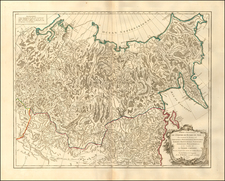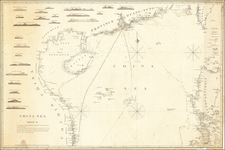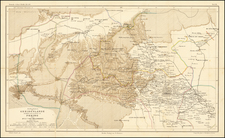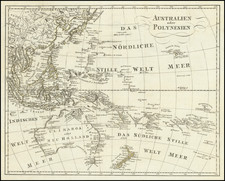Controversial 18th Century Map of Korea, Japan and Part of China, Identifying the Liancourt Rocks (Dokdo) as Korea's Possession
Nice example of this rare and controversial regional map, which appeared in Hayashi Shihei's 三國通覽輿 [ Sangoku tsüran yochi rotei zensu General Route Map of Three Countries]. The work was a rare book with 5 maps, which described the customs of three countries - Kankoku (Korea) , Yezo or Ezo (present day Hokkaido), and Ryükyü (present day Okinawa).
This particular map, showing Japan, Korea and part of China includes the disputed islands, known to the Japanese as Takeshima たけしま/竹島, Dokdo - 독도/獨島 to Koreans and Liancourt Rocks to English speakers, crucially marked as "Korea's possession". This is used by Korea as evidence for the legitimacy of their claim. The book and its accompanying maps, were an attempt to define Japan's borders and were banned on publication because the author, Hayashi Shihei, criticised Japanese maritime defense policy. As frequently is the case, the banning of Sangoku tsüran zusetsu did nothing to deter interest in what Hayashi Shihei had to say and copies of the maps were made and circulated underground. This copy appears to be one of these underground copies.
At the time of its publication Ha Yezo was only partially occupied by the Tokugawa government and although from 1609 Ryükyü was in reality under the control of the Shimazu clan in Satsuma (present Kagoshima Prefecture), the Shimazu clan allowed it to be an independent country superficially. Th present map, Sangoku tsüran yochi (General Route Map of Three Countries) is one of the four maps. The other four maps are: a map of Ryükyü (琉球島圖), Yezo (蝦夷國全図), the eight provinces of Korea (朝鮮八道圖), and Ogasawara Islands (無人島圖).
Kanji numbers are neatly written in the border framing the map showing longitude and latitude. At first glance this suggests accuracy but in fact the map does not accurately reflect scientific knowledge in Japan at that period. Only a few years before in 1779, Nagakubo Sekisui published a much more accurate map of Japan. The map is imprecise, especially as the map maker moved further from the familiar regions of Honshu, Kyushu, and Shikoku. However it is clear that Hayashi Shihei's intention was not to concern himself with cartographical detail but as he says on the map itself "This is a small map to show the geographical relations between Japan and neighboring countries such as Korea, Ryükyü, Yezo, Sakhalin, Kamchatka, and Sea Otter Island [Urup]." As this text suggests, the purpose was to show the location of Japan amongst her neighboring countries rather to give a precise description of Japan and these countries. Previously in Japan there had been not much interest in mapping the region outside of Japan however with the increasing visits and incursions into Japanese territory by Russians, Dutch and other outsiders it became important to define and clarify Japan's borders.
The manuscript is not dated but almost certainly this copy was made in the late Edo period, late 18th to early 19th century.
The Liancourt Rocks Dispute
The Liancourt Rocks dispute is a territorial dispute between Japan and South Korea. Both countries claim sovereignty over the Liancourt Rocks, a group of small islets in the Sea of Japan which they refer to as "Takeshima" or "Dokdo" respectively. North Korea also claims sovereignty of the islands.
The Liancourt Rocks have been administered by South Korea since 1954 by the Korea Coast Guard. This action was taken after the United States stated in the Rusk documents that the Japanese claim to the Liancourt Rocks would not be renounced in their peace treaty with Japan. In 1954, Japan proposed a reference to the International Court of Justice, which South Korea rejected, believing that the Liancourt Rocks are irrefutably South Korean territories, and thus should not be dealt through diplomatic negotiations or judicial settlement between South Korea and Japan.
There are conflicting interpretations about the historical state of sovereignty over the islets. Korean claims are partly based on references to a Korean island called Usan-do in various historical records, maps and encyclopedias such as the Samguk Sagi, Annals of the Joseon Dynasty, Dongguk Yeoji Seungnam, and Dongguk munheon bigo. According to the Korean view, these refer to today's Liancourt Rocks, while the Japanese researchers of these documents have stated that the various references to Usan-do refer at different times to Jukdo, its neighboring island Ulleungdo, or a non-existent island between Ulleungdo and Korea.
Researchers disagree on who first had administrative control over the islets due to ambiguities in early historical records and maps, partly due to changes in the names of the islands in the area over the years.









![[San Francisco to British Columbia] Carta particolare dello stretto di Iezo fra l'America e I'Isola Iezo . . . D'America Carta XXXIII](https://storage.googleapis.com/raremaps/img/small/67788.jpg)


![[American Lady] [Amerika fujin] | [Chinese Man from Nanjing] [To Daishin Nankin-jin]](https://storage.googleapis.com/raremaps/img/small/55554.jpg)

